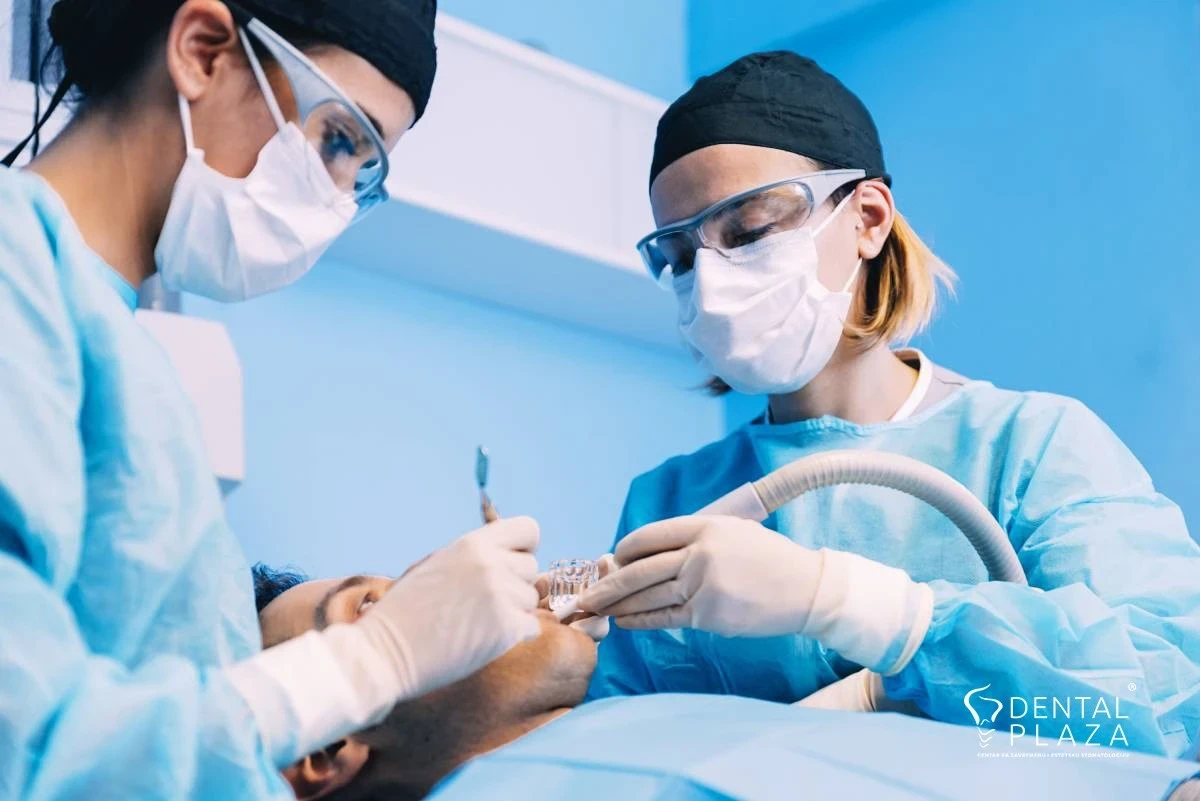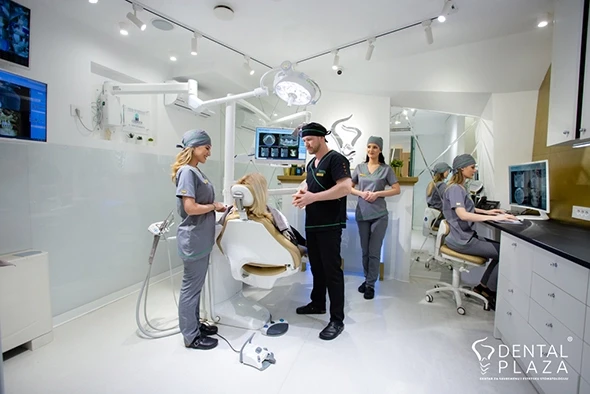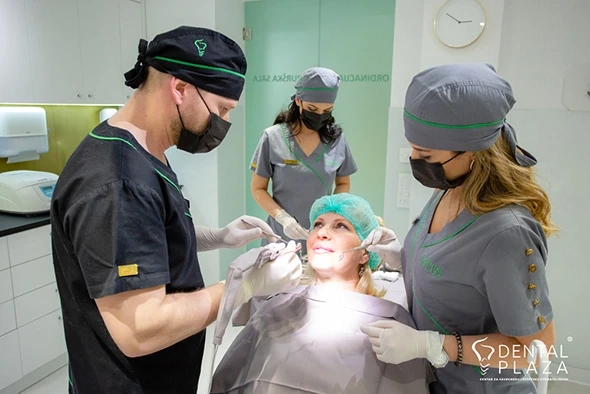Do not be shy, show your teeth!
Call Center 08-21h
Do not be shy, show your teeth!
Call Center 08-21h

Oral surgery is a branch of dentistry that includes many different interventions, and some of them are: implant placement, wisdom tooth extraction, tooth root resection, frenectomy, cystectomy… With the help of oral surgical interventions, various problems that patients have because of their teeth can be eliminated, and sometimes these interventions are the last hope for a tooth to be preserved.
All oral surgical interventions are performed under the action of local anesthesia, so they are completely painless and comfortable for patients. The recovery period after the intervention can last up to several days when it is necessary to avoid physical activity, cigarette consumption and, if necessary, to use analgesics or antibiotics with the obligatory consultation with an oral surgeon. If surgical suturing of the wound is performed during these interventions, it may be necessary to remove the sutures 7 to 10 days after the intervention.
Depending on the type and complexity of the surgical intervention, the duration of the procedure is different. Sometimes this procedure can last up to 15 minutes, and sometimes up to 2 hours if it is a more complex, such as implant placement in both jaws or removal of a large jaw cyst.
What interventions does oral surgery involve?
1. Extraction of teeth - tooth extraction involves the removal of teeth from the alveoli (bone cup). This procedure is usually routine, but can sometimes require an oral surgical approach. This is most often the case when it is necessary to remove the wisdom tooth, or with any other impacted tooth, residual root, etc. However, for a professional dentist, wisdom tooth extraction is a routine procedure, and therefore the patient has no reason to fear.
2. Resection of the tip of the tooth root (apicotomy) - Apicotomy is a surgical intervention that is performed under local anesthesia, during which the tip of the root is cut off and the pathological process (purulent formation) that has formed on it is removed. In that process, the formed periapical processes or cysts are usually eliminated. Apicotomy prolongs the life of teeth and prevents their premature loss.

3. Implantology - Implantology is today one of the most popular areas of dentistry. Implants are biocompatible tooth root substitutes that are implanted in the bone. They almost completely replace the lost tooth, without the need to grind the neighboring ones, and they can be used in cases of loss of one or all teeth. Implant placement is one of the most modern dental procedures.
4. Artificial bone implantation - In places where tooth loss has occurred, there is a gradual loss of alveolar bone over time. This can be a problem when it comes time to place an implant in that place. In order to provide enough bone tissue when implant placement is planned, augmentation procedures are performed, ie. implantation of artificial bone.
5. Sinus lift - Sinus lift is a surgical intervention that increases the height of the jawbone in the lateral regions of the upper jaw, in the region of the premolars and molars, by raising the membrane at the lower edge of the maxillary sinus, creating a post for artificial bone to be placed there. If implant placement is planned in the lateral regions of the upper jaw, and the patient does not have enough bone to accommodate the implant and its adequate osseointegration, then a sinus lift intervention can be performed beforehand to provide a sufficient amount of bone to place the implant.

6. Frenectomy - Frenectomy is a surgical procedure that removes the villi, or frenulum that connects the upper or lower lip to the gums, as well as the villi that connects the tongue to the floor of the oral cavity. Frenulas are fibrous formations in the oral cavity, better known as "fringes". Their function is to limit excessive movements. However, sometimes they can be more pronounced, which leads to certain consequences. There are two methods for removing the frenulum, ie. frenectomy: surgical method and laser frenectomy.
7. Cystectomy - Jaw cysts are sac-like formations in the bones of the jaws that occur for various reasons - sometimes it is a long-term infection, sometimes not emerged tooth, and sometimes some kind of trauma. It is very important that they are completely removed as soon as possible, so that they do not reappear and do not endanger, not only other teeth, but also the sinuses, nasal cavities, jaws. Cystectomy removes these formations, mostly completely, and if they make large defects in the bone, it can be replaced with artificial bone in the same intervention.
Do you have questions?

Oral surgery is a branch of dentistry that includes many different interventions, and some of them are: implant placement, wisdom tooth extraction, tooth root resection, frenectomy, cystectomy… With the help of oral surgical interventions, various problems that patients have because of their teeth can be eliminated, and sometimes these interventions are the last hope for a tooth to be preserved.
All oral surgical interventions are performed under the action of local anesthesia, so they are completely painless and comfortable for patients. The recovery period after the intervention can last up to several days when it is necessary to avoid physical activity, cigarette consumption and, if necessary, to use analgesics or antibiotics with the obligatory consultation with an oral surgeon. If surgical suturing of the wound is performed during these interventions, it may be necessary to remove the sutures 7 to 10 days after the intervention.
Depending on the type and complexity of the surgical intervention, the duration of the procedure is different. Sometimes this procedure can last up to 15 minutes, and sometimes up to 2 hours if it is a more complex, such as implant placement in both jaws or removal of a large jaw cyst.
What interventions does oral surgery involve?
1. Extraction of teeth - tooth extraction involves the removal of teeth from the alveoli (bone cup). This procedure is usually routine, but can sometimes require an oral surgical approach. This is most often the case when it is necessary to remove the wisdom tooth, or with any other impacted tooth, residual root, etc. However, for a professional dentist, wisdom tooth extraction is a routine procedure, and therefore the patient has no reason to fear.
2. Resection of the tip of the tooth root (apicotomy) - Apicotomy is a surgical intervention that is performed under local anesthesia, during which the tip of the root is cut off and the pathological process (purulent formation) that has formed on it is removed. In that process, the formed periapical processes or cysts are usually eliminated. Apicotomy prolongs the life of teeth and prevents their premature loss.

3. Implantology - Implantology is today one of the most popular areas of dentistry. Implants are biocompatible tooth root substitutes that are implanted in the bone. They almost completely replace the lost tooth, without the need to grind the neighboring ones, and they can be used in cases of loss of one or all teeth. Implant placement is one of the most modern dental procedures.
4. Artificial bone implantation - In places where tooth loss has occurred, there is a gradual loss of alveolar bone over time. This can be a problem when it comes time to place an implant in that place. In order to provide enough bone tissue when implant placement is planned, augmentation procedures are performed, ie. implantation of artificial bone.
5. Sinus lift - Sinus lift is a surgical intervention that increases the height of the jawbone in the lateral regions of the upper jaw, in the region of the premolars and molars, by raising the membrane at the lower edge of the maxillary sinus, creating a post for artificial bone to be placed there. If implant placement is planned in the lateral regions of the upper jaw, and the patient does not have enough bone to accommodate the implant and its adequate osseointegration, then a sinus lift intervention can be performed beforehand to provide a sufficient amount of bone to place the implant.

6. Frenectomy - Frenectomy is a surgical procedure that removes the villi, or frenulum that connects the upper or lower lip to the gums, as well as the villi that connects the tongue to the floor of the oral cavity. Frenulas are fibrous formations in the oral cavity, better known as "fringes". Their function is to limit excessive movements. However, sometimes they can be more pronounced, which leads to certain consequences. There are two methods for removing the frenulum, ie. frenectomy: surgical method and laser frenectomy.
7. Cystectomy - Jaw cysts are sac-like formations in the bones of the jaws that occur for various reasons - sometimes it is a long-term infection, sometimes not emerged tooth, and sometimes some kind of trauma. It is very important that they are completely removed as soon as possible, so that they do not reappear and do not endanger, not only other teeth, but also the sinuses, nasal cavities, jaws. Cystectomy removes these formations, mostly completely, and if they make large defects in the bone, it can be replaced with artificial bone in the same intervention.